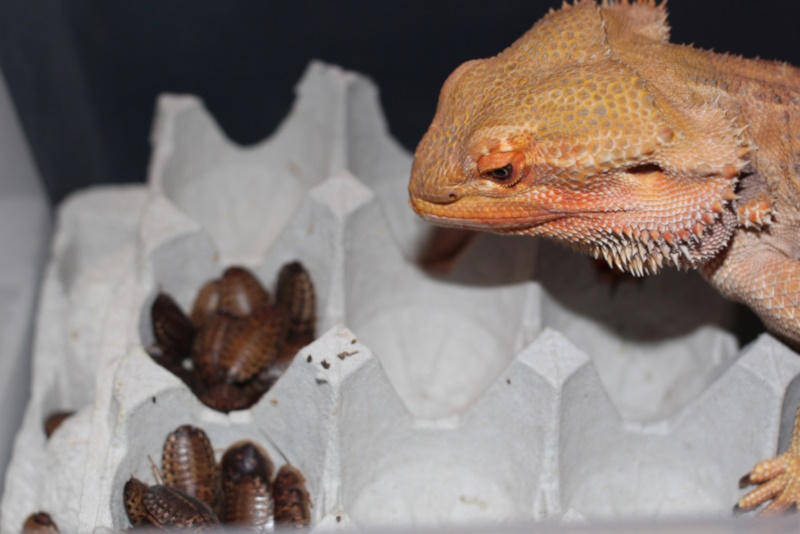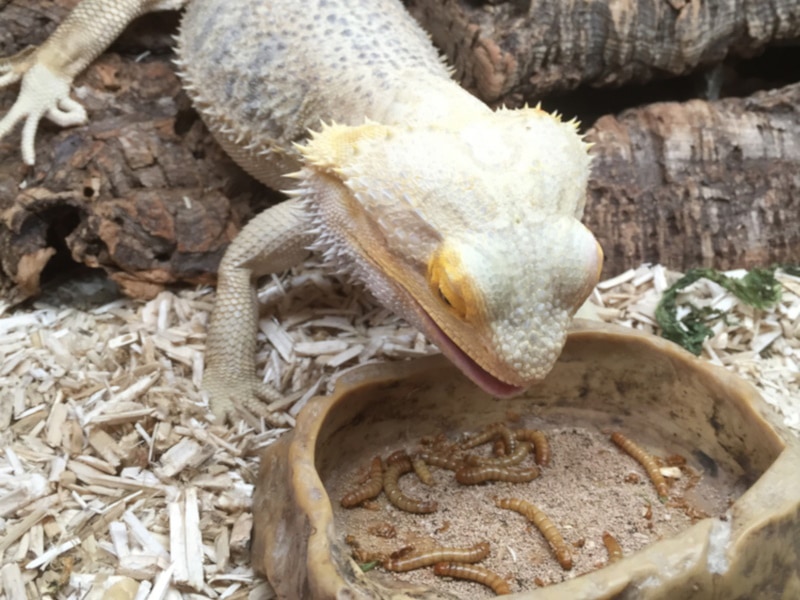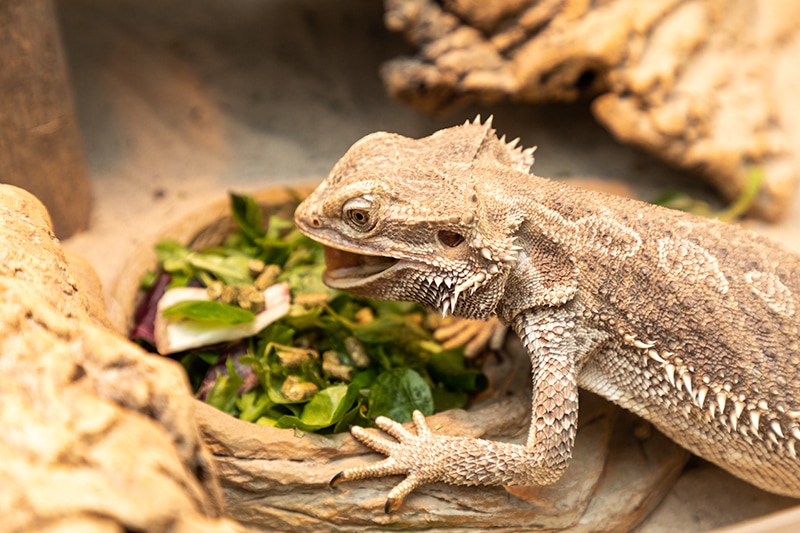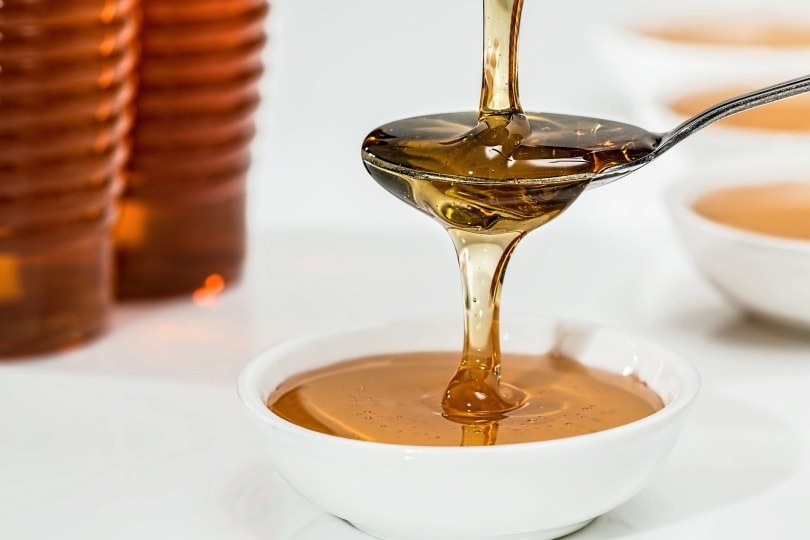Can Bearded Dragons Eat Dubia Roaches? Vet-Reviewed Nutrition Facts & FAQ
By Ashley Bates
Updated on

Click to Skip Ahead
Bearded dragons might be omnivorous creatures, but they thrive on protein building blocks. If you already own a beardie, you know how much they enjoy chowing down on some gut-filling, protein-rich insects.
There are many insect choices at pet shops, but which are the best for your bearded dragons? If you have encountered Dubia roaches, are they a prime protein source? Yes! Not only can your bearded dragon enjoy Dubia roaches, but they are also easy to keep and even breed.
Bearded Dragons Can Eat Dubia Roaches
Bearded dragons not only can consume Dubia roaches—they absolutely should eat Dubia roaches! These nutritious insects provide bountiful nutrition for your beardie but should still be gut loaded for optimum benefit. Because of their high nutritional profile, they make very good starter insects for juvenile bearded dragons.
A young bearded dragon can eat up to 50 small roaches in one day. As they age, this number will significantly decrease. An average adult only needs about 3 to 5 large dubia roaches every 2 to 3 days.
Health Perks of Dubia Roaches for Bearded Dragons

Dubia roaches (Blaptica dubia) are one of the most versatile insects you can buy for your reptile. You can find them at virtually any pet shop or online store unless your state prohibits them. Here are some specific health benefits of Dubia roaches for bearded dragons.
Loaded with Protein
Dubia roaches have tons of healthy protein. A single Dubia roach contains 22% protein on an as fed basis (54% on a dry matter basis). This well surpasses the minimum required for bearded dragons (30-50% DMB), and it is at the top of the list for feeder insects as well.
Provides Hydration
Dubia roaches provide your bearded dragons with important hydration. While they still need a freshwater source, many insectivorous omnivores like your bearded dragon get much hydration from their prey. Although they may not look it, Dubia roaches are around 60% water.
Support Life
Because these roaches give your bearded dragon so much of their daily nutritional content, they can support their lives through the juvenile to adult stages. The only thing that will change throughout your bearded dragon’s life is the frequency of dubia roach meals.
Dubia Roaches Are Easy to Keep

Dubia roaches are very low-maintenance insects to keep. You have to keep them in temperatures between 50 and 80 degrees Fahrenheit. They might be able to survive in higher or lower temperatures, but you should stay in this comfortable 30-degree window.
If you’re trying to get a more robust roach, you can increase those temperatures to between 70- and 90-degrees Fahrenheit. They love heat and humidity!
While you can offer these roaches water, they get most of their hydration from the fruits and vegetables they consume. The longer you plan on keeping the roaches, the more important it is to give your roaches a dish of clean water.
One problem with leaving water in the enclosure is when it comes in contact with substrate, feces, and discarded exoskeletons, which can lead to mold and bacterial growth. It is important to change out the water and keep things hygienic for them.
Dubia Roaches Don’t Smell
Unlike some other store-bought insects, Dubia roaches have no strong smell. Other insects, such as crickets, emit a distinctive odor when numbers are large. Luckily, you don’t have to deal with any of that when dealing with Dubia roaches.
While these roaches can get a little stinky due to environmental factors like rotting food, mold, or moisture in the enclosure, these things have nothing to do with the roach itself.
If you clean their environment properly and remove any expired food, your Dubia roaches will essentially be scentless.
Can Dubia Roaches Infest Your Home?

You might hear the term “roach” and run for the hills. After all, cockroaches have given most roaches a bad name, infesting the homes of people worldwide. So, will you face an inevitable infestation if a Dubia roach gets out in your house?
Luckily, it’s improbable that Dubia roaches will infest your home. These little guys are kept and bred by various reptile lovers without issue. If one escapes, it’s highly more likely to die from an improper environment than to breed.
That is because a house is generally not humid or warm enough to create a good breeding environment for these roaches. They need a specific set of factors to reproduce successfully. Often, a person’s home is an undesirable space.
However, in certain parts of the world, Dubia roaches are outlawed. If they can survive in the habitat around them, the state refuses to let folks keep them. Some of these regions include:
- Florida
- Georgia
- Louisiana
- Alabama
- Hawaii
- Canada
Most of the time, this is because most of these regions have very hot, humid climates. When they get out of the home, they are able to reproduce in large numbers. They can quickly become invasive in the environment.
Therefore many states choose to avoid the breeding, transport, and distribution of these insects.
How to Breed Dubia Roaches
If Dubia roaches are allowed in your state, you can get them at a local pet shop or from private sellers. These roaches are simple to keep and require very little care. If you want to breed them yourself, they are straightforward to multiply.
These beetles have a rapid reproductive cycle, and you can easily keep it going as time passes. Constantly buying insects from a pet store can get very pricey, especially if you’re going to chain stores. Even buying online can get a little heavy eventually.
So if you’re the kind of person who loves to save money and you don’t mind a little extra work, you can certainly get into breeding Dubia roaches. Actually, if you keep Dubia roaches, it might become a natural process regardless of your efforts.
- Choose a suitable container.
- Give access to fresh fruits and water.
- Keep humidity high.
- Offer temperatures above 70 degrees.
- Remove debris, dead insects, and old water from the enclosure.
- Focus on maintaining nutrition and environment.
Interestingly, unlike many other insects, these roaches are ovoviviparous. Instead of laying eggs, the female will create long tube-like egg sacs called ootheca. They will hatch over several hours.
While born white, Dubia roach larvae will turn gray just a few hours after their exoskeletons harden from air exposure. They are extremely fragile at this stage, and you should refrain from touching or handling them.
Other Insects for Bearded Dragons

So now you know all the upsides, ins, and outs of keeping Dubia roaches. These insects make an excellent food source for bearded dragons, and we highly recommend them. However, your beardie will enjoy and needs variety to thrive.
- Superworms
- Mealworms
- Crickets
- Domestic silk moth
- Earthworms
Never feed your bearded dragon wild-caught insects. These insects can carry toxins, parasites, and bacteria that can greatly impact the overall health of your bearded dragon. Store-bought, privately bred, or self-bred insects are the way to go.
Feeding Schedule for Bearded Dragons
Your bearded dragon is an omnivore that needs a broad selection of foods and a regular diet. Bearded dragons need to be fed according to life stages, most importantly.
For example, if you have a juvenile bearded dragon, they will need a lot of gut-loaded insects multiple times a day. You can still feed them a small portion of fruits and vegetables, but protein is the most important part of their diet at this time.
If you have an adult bearded dragon, they need a very good 50/50 mix of insects and plant material. You also don’t have to feed adult bearded dragons as often. You might need to feed your juvenile every day, but you can usually go 2 to 3 days between adult feedings.
Dubia roaches have a naturally inverse Ca:P ratio of 0.66:1. This means that the calcium levels are lower than the phosphorus levels. This can lead to metabolic bone disease in reptiles and hence it is important that the roaches are gut loaded with a high calcium powder around 24 hours before being fed to your bearded dragon.

Conclusion
You’ll be happy to know that not only do bearded dragons absolutely love these gut-filled insects, but they are also easy to keep and breed as well! If you ever get tired of spending money on them, you can quickly see reproduction if you give them the right environment.
Don’t skip on other nutrition. Beardies require plants and a variety of insects to thrive, so ensure you’re feeding them appropriately based on their life stage.
Featured Image Credit: Attezor, Shutterstock











